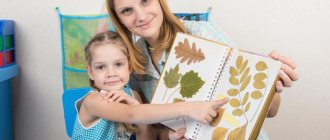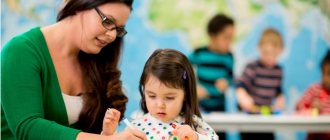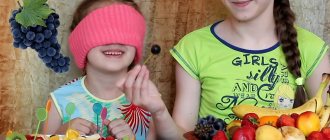MAGAZINE Preschooler.RF
Modeling method in work on environmental education of preschool childrenAt present, the issue of environmental education of preschool children is important, interesting and relevant. Environmental education is a new direction in preschool pedagogy, which differs from the traditional introduction of children to nature. This is the knowledge of living things that are close to the child, in connection with the environment, and on this basis the development of the correct forms of interaction with him. Key words: environmental education, information and computer technologies, design technology, portfolio technology, modeling method, mnemonics. The effectiveness of environmental education depends entirely on the creation and proper use of a developing ecological environment. And also from correctly selected traditional and modern pedagogical technologies. The use of information and computer technologies (layouts, animated presentations, flash games, video clips, etc.) in environmental education allows not only to attract the attention of a preschooler, but to provide deeper, more complete, bright, rich information.
Representatives of the animal and plant world are of great interest to preschool children, whom they perceive as equals, sympathize and empathize with them. Wanting to learn as much as possible, the child asks many questions about plants and animals.
All features of children’s knowledge of the natural world around them must be taken into account when organizing educational activities.
The need to provide children with the opportunity to communicate with nature and conduct joint activities in it is indicated in the requirements of the Federal State Standards of Preschool Education.
The Federal State Educational Standard pays special attention to the organization of a subject-spatial environment, which makes it possible to maximize the potential of each preschooler. Therefore, the equipment of groups must include didactic aids that develop children’s cognitive activity. Layouts are precisely such aids.
Modeling can be considered as an environmentally oriented activity that makes it possible to consolidate children’s ideas about the natural world, transform acquired knowledge into play, enriching the lives of preschoolers with new impressions, and develop their creative abilities.
In early preschool age, children are just beginning to form ideas about living nature. Simple layouts and models created by the hands of teachers and parents form initial ideas about natural objects. The work with younger preschoolers involves looking at layouts and manipulating them. As well as conducting conversations about nature or its objects, the features of which are clearly depicted by the model.
In the lives of older preschoolers, director's play with small toys occupies a large place, when the child creates an imaginary situation, invents an event with characters, identifying himself with them, performing one of several roles, and models real social, environmentally oriented relationships in a playful form.
Similar ideas are found in the works of S. N. Nikolaeva,
N.N. Poddyakova, who developed a system aimed at teaching children various types of design, including prototyping, as a means of building their own activities. According to leading researchers, L. S. Vygotsky and N. P. Podyakov, using models and activities with them, we find an opportunity to “immerse” children in the amazing kingdom of nature
From work experience it is clear that model activities contribute to the formation in preschoolers of a desire for harmonious coexistence with the natural world and the development of cognitive activity.
During the creation of layouts and games with them, the following tasks are solved:
- develop logical thinking, memory, attention of children
- develop monologue and coherent speech, activate vocabulary, develop writing skills
- strengthen children's knowledge about the natural world
- develop the ability to work in a team
- to instill in children a caring attitude towards nature, a desire to protect and help it
- promote the formation of communication skills
- strengthen children's knowledge about the natural world
- consciously form the correct attitude towards representatives of the flora and fauna
According to A. A. Kameneva, the model is the result of constructive, creative, environmental activity and a very attractive playing space, and even the period of making the model itself has value, being a learning process in itself.
The work of creating a layout, to which parents must be involved, since the effectiveness of the educational process depends on their direct participation, is carried out in several stages:
Stage 1: preliminary work.
During the stage, children have conversations about nature and its objects, watch presentations, look at paintings, illustrations, conduct observations on walks, read fiction, and so on. Thus, at the first stage, the personal experience of preschoolers is enriched, as well as the collection of material to create a model.
Stage 2: making the basis of the future layout and filling it with object material.
During the work at this stage, we include elements of artistic and visual creativity, design, and modeling. In the process of joint productive activities with children, additional elements, characters, surroundings are made from cardboard, paper, salt dough, natural and waste materials, which are an obligatory part of the layout and allow it to be turned into a play space. When creating a model, each child chooses the type of activity he likes most, be it design, modeling, modeling, drawing, appliqué, and so on. At this stage, children’s ideas about natural landscapes, art, architecture, and rules of behavior in nature are formed.
Stage 3: children’s active games and the use of models during educational activities.
Our group has developed and created the following layouts:
- "Pets"
- "Inhabitants of the North"
- "Aquarium"
- "Seasons"
It is important that the results of joint creativity do not gather dust on the shelves. They were used both in independent children’s play and in the process of joint and direct educational activities.
Thus, playing with layouts and models is an environmentally oriented activity that forms children’s holistic view of nature and promotes children’s understanding of the relationships in nature and with nature. Allows you to transform acquired knowledge into play, saturating children's lives with new impressions and stimulating children's creativity.
| Next > |
Modeling in environmental work with children article on the surrounding world (senior group)
LAYOUT IN ECOLOGICAL WORK WITH PRESCHOOL CHILDREN
Pirogova Elena Anatolyevna
Russia, Nizhny Novgorod
e-mail: [email protected]
annotation
The article presents material on the use of models in environmental work with preschoolers: the stages of creating models, the selection of didactic game material for including models in joint educational activities with children.
Environmental education of children in preschool age is of great importance as the initial stage of the environmental education system. Mastering the basics of environmental knowledge is most promising at this age, because a child perceives nature very emotionally, pays attention to features of nature that an adult would not even notice. A child is able to be surprised by what surrounds him and asks a lot of questions about plants and animals. He perceives animals as equals, sympathizes with them, and empathizes with them.
According to the requirements of the Federal State Standards of Preschool Education, the subject-spatial environment must provide the opportunity for communication and joint activities of children and adults, and ensure the maximum realization of educational potential. Materials that activate cognitive activity are required in the equipment. Such materials are layouts. We consider modeling as an environmentally oriented activity that helps consolidate ideas about the world, allows you to transform acquired knowledge into play, saturating children's lives with new impressions and stimulating children's creativity [1].
N.N. Poddyakov and L.Ya Paramonova, based on the results of psychological and pedagogical research, developed a system aimed at teaching children various types of design, including prototyping as a means of building their own activities. The authors recommend finding opportunities to “immerse” children in the amazing kingdom of nature [2].
We believe that model activities contribute to instilling in children the desire to be in harmony with the nature that surrounds them, maintaining and developing positive motivation for activities in nature, and developing cognitive interest.
In the process of creating layouts and playing with them, we solve the following problems:
- Fostering emotional responsiveness, the desire to protect and preserve nature.
- Consolidating and generalizing children's knowledge on a particular topic.
- Speech development (development of monologue and connected speech, activation of lexical speech, formation of writing skills).
- Development of general and fine motor skills of the hands.
- Development of logical thinking, memory, attention.
- Development of communication skills, ability to work in a team.
The layout is the result of constructive and creative activity, environmental activity and a very attractive play space. The period of making a model has intrinsic value and is a learning process in itself. [3].
We carry out the work on creating the layout in three stages:
Stage 1 - preliminary work
- Enriching the personal experience of children (we conduct conversations, look at paintings, illustrations, use an interactive projector to watch educational programs on the topic, walks and excursions, read fiction, etc.).
- Preparation and collection of material to create a layout.
Stage 2 - making the base of the model and filling it with object material. In the work at this stage we include elements of design and artistic and visual creativity in the form of sculptural modeling from plastic materials, we form ideas about natural and cultural landscapes, and the art of architecture. Characters, additional elements, surroundings, which are an integral part of the layout and allow you to turn it into a play space, are made in the process of joint productive activities with children from paper, cardboard, wire, plasticine, salt dough, natural and waste materials. In the process of creating a model, each child can choose the type of activity that is most attractive to him (design, modeling, sculpting, appliqué, etc.). We also involve parents of students in the work of creating mock-ups; the effectiveness of the educational process depends on their direct participation. They invited parents to select materials and make a model at home to participate in the “Best Family Model” competition.
Stage 3 – the process of developing and intensifying the game with the layout.
Based on ready-made models, we conduct environmental classes dedicated to familiarizing children with various biocenoses. Our group has created the following models: “Antarctica” (Fig. 1), “Forest” (Fig. 2), “Mountains”, “Desert” (Fig. 3), “Australia”, “World of Insects”, “Ocean”, "World of Dinosaurs" and others.
Fig. 1.-Layout of Antarctica
Fig.2.-Layout Forest Fig.3.-Layout Desert
When planning games with layouts, we set the following tasks [4]:
- Based on the existing layout with objects (figurines, space layouts, objects that help perform actions), come up with a plot and develop it alone or with partners.
- To play with the layout, select substitute objects, enriching the subject environment of the game.
- Together with children, create a subject environment for layouts, enriching the plot.
- Invent new plots, combining several layouts, combining realistic and fantastic events into a plot.
The table below shows a number of interesting tasks, methods and techniques that can be used when working with layouts.
Table 1
| Methods and techniques | Content |
| Thematic conversation “Lessons of kindness” | “What does it mean to be kind?” "What is the beauty of a flower" “Harmony of colors” (sounds) “What’s so amazing about a frog?” “What nature told you”, etc. |
| Solving problem situations | -A character from one climate zone (layout) ended up in another climate zone? What will happen to him? How can I help him? — A chick fell out of the nest. What actions will you take? -How to best arrange the layout characters (for example, herbivores and predators) -Which materials are best to make this or that layout. |
| Tasks - reasoning | - It takes a long time to pick berries one by one in the forest. It’s easier to break branches with berries. Is it possible to do this? -The children brought home a small and helpless bunny. What do you tell them? Express your attitude towards their actions. etc. -Why was the polar bear included in the Red Book? |
| Brainstorm | “Why does the Christmas tree have green needles?” “Why is the wolf called the orderly of the forest?” etc. - “Fire is a friend, fire is an enemy” - “How to help a broken tree?” - “Who ate the squirrel supplies?” and so on. — “What comes first, what comes next” (growth and development of living organisms) — “Choose the right road” (rules of behavior in nature). - “Who is the odd one out?” (Identification of an animal in the wrong climate zone). |
| Didactic games | - "Who lives where?" — “Flies, runs, jumps” (adaptation of animals to their environment) - “Who has what house?” (knowledge of ecosystems) |
| Observations | -Comparison of the nature of two climate zones (layouts) -Comparison of animals of the north and the desert (adaptation of animals to their environment) |
| Creative tasks for layouts | -Drawing environmental signs. -Making model characters from plasticine, paper, waste material. -Composing stories about the characters of the model (about a little penguin who was lost; about a monkey who was looking for friends, etc.). — Incorporating layouts into the director's game. |
The created gaming space is constantly replenished with new gaming material, and substitute items are used. Together with the children, we come up with stories and fairy tales, which later serve as game plots. The layouts we use are multifunctional, a means of engagement that forms children’s holistic understanding of nature, promotes children’s understanding of the relationships in nature and with nature, and arouses interest and love for nature.
Bibliography
1. Nikolaeva S.N. Education of ecological culture in preschool childhood. -M., 1995
2. Serebryakova T.L. Environmental education in preschool age. - M., 2006
3. Kameneva A.A. How to introduce preschoolers to nature: A manual for kindergarten teachers. - M., 1983
4.Zebzeeva V.O. On the forms and methods of environmental education for preschool children //Preschool education 1998, No. 7
Layout “Natural-climatic zones”
Layout "Naturally"
—
climatic zones"
Explanatory note
Nowadays, the problem of the environment is the most pressing and is attracting more and more attention, so one of the priority areas in the modern standard of preschool education is environmental education.
. It has important social significance for the entire society. According to the requirements of the Federal State Educational Standard, the subject-spatial environment must provide the opportunity to enhance the cognitive activity of children. This material is the layout.
Layout “Natural-climatic zones”
forms part of the ecological room in our children's institution. Using a model, children visually become familiar with the features of different natural and climatic zones, with their flora and fauna. They can travel from northern to southern regions, observe how the picture of nature changes, and think about why this is happening.
Layout purpose
: to form ideas about the natural (landscape) areas of our planet.
In the process of working with the layout, the following tasks
:
— introduce children to different natural areas or consolidate this knowledge;
— enrich children’s ideas about the nature and living conditions of flora and fauna in different natural zones;
- systematize children’s ideas about the ability of flora and fauna to adapt to their environment. Give the concept that all plants and animals are in the places to which they are adapted;
- to develop children’s ability to differentiate between flora and fauna according to their habitat;
- expand and enrich children’s passive and active vocabulary;
— develop children’s cognitive activity, the ability to analyze and draw conclusions;
— to form emotional responsiveness and curiosity;
— to cultivate a caring attitude towards nature and environmental awareness.
The layout is based on the panorama principle
. To create the layout, small boxes measuring 40x40 cm and 20 cm deep were used. On the inside of each box, a panorama of the natural area with its features is drawn. The bottom is lined depending on the natural zone: desert - colored semolina, Arctic - polystyrene foam, forest zone - artificial grass, etc. Each box is “populated” with the corresponding animals.
View of each box
games are used in the process of working with the layout:
:
“Help me find a house”, “Find a mistake”, “What has changed?”, “Continue the series”
Goal: to develop children’s ability to differentiate the animal and plant worlds according to their habitat.
"Find out by description"
Goal: To learn to focus on the endings of words when agreeing adjectives and nouns in gender.
"Who am I?"
Goal: To concretize children’s idea of a particular animal, to teach them to name its qualities and actions.
"Writer"
Goal: learn to write a descriptive story about a natural area.
“Inhabitants of the desert, taiga, forest, etc.”
Goal: To consolidate the names of animals in different natural zones, their habits, appearance, what they eat, etc.
Story games: “Desert”, “Taiga”, “Forest”, “Africa”, “Jungle”, “Arctic”.
Goal: To promote the creative use of ideas about the surrounding life in games. To develop the ability to negotiate, plan and discuss the actions of all players.
As a result of working with the model, children begin to design and recreate different natural areas themselves in their independent play activities
. The photo shows the result of children's activities.
Thank you for your attention.



